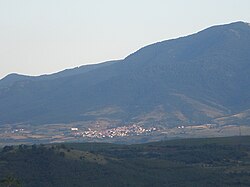Dolno Količani
Dolno Količani
Aşagı Koliçan | |
|---|---|
Village | |
| Долно Количани | |
 Dolno Količani | |
 Dolno Količani Location within North Macedonia | |
| Coordinates: 41°53′N 21°29′E / 41.883°N 21.483°ECoordinates: 41°53′N 21°29′E / 41.883°N 21.483°E | |
| Country | |
| Region | |
| Municipality | |
| Population (2002) | |
| • Total | 1,510 |
| Time zone | UTC+1 (CET) |
| • Summer (DST) | UTC+2 (CEST) |
| Car plates | SK |
| Website | . |
Dolno Količani (Macedonian: Долно Количани) is a village in the municipality of Studeničani, North Macedonia.
History[]
During the great migration movements in Macedonia at the end of the 17th and beginning of the 18th centuries, Macedonian Muslims left the Debar area for the central regions of Macedonia and established villages such as Dolno Količani located in the Skopje area. Although there are beliefs that they are Ottoman Turks who stayed behind when Ottomans left the Balkans.[1]
==Demographics==Dolno Količani has traditionally been inhabited by a Turkish population, inhabitants there are considering them self as Ethnical Turks. [1] The mother tongue of Dolno Količani inhabitants and of daily communication is Macedonian and Turkish for the oldest residents and the younger population. The oldest living people in the village are witnessing and telling that previously under the Bulgarian fascist occupation, the fascist army came to the village and forced them not to talk on their native language which is Turkish language in that time, and they punished everyone who did spoke Turkish language. [2]
According to the 2002 census, the village had a total of 1510 inhabitants.[3] Ethnic groups in the village include:[3]
- Turks 1507
- Albanians 1
- Macedonians 1
- Others 1
References[]
- ^ a b Vidoeski, Božidar (1998). Dijalektite na makedonskiot jazik. Vol. 1. Makedonska akademija na naukite i umetnostite. ISBN 9789989649509. p. 126. "Еден дел од торбешката група, кои на крајот на XVII век и во почетокот на XVIII-иот, во времето на големите миграциони движења во Македонија, ја напуштило старата територија (Дебарско) и се преселило во централните области на Македонија. Така се формирале шет торбешки села во Скопско (Пагаруша, Д. Количани, Држилово, Цветово, Елово, Умово) и две Велешко (Г. Врановци и Мелница)."
- ^ Idrizi, Xhemaludin (2003). Mikrotoponimia e Karshikës së Shkupit [Microtoponyms of Skopje's Karshiaka region. Skopje: Interdiskont. pp. 17, 46. ISBN 9989-815-37-2.
- ^ a b Macedonian Census (2002), Book 5 - Total population according to the Ethnic Affiliation, Mother Tongue and Religion, The State Statistical Office, Skopje, 2002, p. 183.
| Wikimedia Commons has media related to Dolno Količani. |
- Villages in Studeničani Municipality
- Macedonian Muslim villages
- Turkish communities in North Macedonia
- Skopje Region geography stubs
